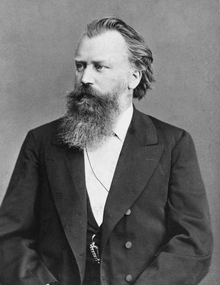1st string quintet (Brahms)
The 1st string quintet in F major op. 88 by Johannes Brahms (1833–1897) was written in Bad Ischl in the spring of 1882 and was premiered in December of the same year.
Origin, premiere and printing
Johannes Brahms had already dealt with the string quintet genre in the early 1860s and decided to use two cellos. However, the result did not satisfy him; He later reworked the unsuccessful draft for his Sonata in F minor for two pianos, Op. 34b and the Piano Quintet in F minor, Op. 34a.
In a renewed examination of this chamber music genre around 20 years later, Brahms chose the instrumentation model with two violas already preferred by Mozart . During a stay in Bad Ischl in 1882 - the manuscript notes explicitly "in spring 1882" behind both corner movements - he wrote his 1st String Quintet in F major, which was given the opus number 88. During his stay in Ischl he completed two more works: The 2nd Piano Trio in C major, Op. 87 and the Song of Parzen, Op. 89.
In October 1882 Brahms played the quintet together with the Hellmesberger Quartet with the medical friend Theodor Billroth . The public premiere took place on December 29, 1882 in Frankfurt a. M. instead, played by the Heermann-Müller Association. The first print appeared in 1883 in the Berlin publishing house N. Simrock, headed by Fritz Simrock. The autograph of the work has been in the property of the Brahms Society Baden-Baden since 1971, which published a facsimile . The autograph of the arrangement for piano four hands is in the Brahms archive of the Hamburg State and University Library.
characterization
The first string quintet in F major op. 88 by Johannes Brahms, which is predominantly characterized by a cheerful and relaxed mood, is in three movements and lasts approximately 26 minutes.
I. Allegro non troppo ma con brio
Intoned from one of the first violin, folk-song-simply acting topic develop soon other thoughts, as a motive in dotted rhythm, which is also in the implementation is used. The secondary theme, marked by quarter triplets, is presented by the 1st viola.
II. Grave ed appassionato - Allegretto vivace - Tempo I - Presto - Tempo I
The second movement is in five parts (AB A 'B' A '') and shows the interlacing of a slow movement with a Scherzo . In the melancholy opening part, Brahms uses thematic material from a saraband for piano from around 1855, as well as in the middle and final parts. The two quick, cheerful parts 2 and 4 also draw on a piano piece composed around 1855, this time a gavotte in A major.
III. Allegro energico - Presto
Here the composer combines the sonata form with a sophisticated contrapuntal fugue technique , as the first theme introduced by the first viola and continued in fugato shows - after two fort chords . In the coda , the overall exuberant mood is further heightened by a Presto in nine-eighth time.
The extremely self-critical Brahms described his 1st string quintet in a letter to Clara Schumann from August 1890 as “[...] one of my prettiest pieces [...]”.
Individual evidence
- ↑ Werner Hoppe: On the autograph of the string quintet No. 1 in F major op. 88 by Johannes Brahms . In: Johannes Brahms Society (Ed.): Brahms Studies Vol. 10, Hamburg 1994, pp. 53–56.
- ↑ Brahms Archive: Systematics, p. 1
- ^ Hans Gal (ed.): Johannes Brahms Briefe . Fischer Taschenbuch Verl., Frankfurt a. M., 1979, ISBN 3-596-22139-0 , p. 156
literature
- Hans Renner: Reclam's chamber music guide . Ph. Reclam jun., Stuttgart, 8th edition, 1976, pp. 473-474, ISBN 3-15-008001-0
Web links
- 1. String Quintet op. 88 : Sheet music and audio files in the International Music Score Library Project
- Score, parts and piano reduction; Brahms Institute d. Lübeck University of Music
- Work introduction to chamber music guide, Villa Musica
- Work description John Keillor, Allmusicguide (English)
- Listening Guide (English)
